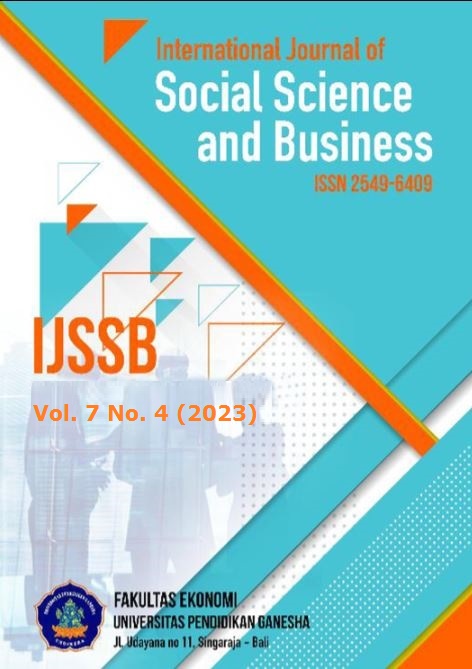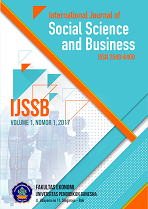Property Corporation Exit Strategy Planning and the Importance of Contingency Leadership
DOI:
https://doi.org/10.23887/ijssb.v7i4.56916Keywords:
Exit strategy, business strategy, contingency leadership, executionAbstract
This study aims to describe exit strategies in the property development services industry and highlight the importance of implementing contingency leadership in XYZ companies. The focus is on a situation where the decline in apartment sales occurs due to the saturation of the property market and the impact of the Covid-19 pandemic. The main objective of the study is to provide an in-depth understanding of exit strategies in the property development industry and to evaluate the role of contingency leadership in dealing with such situations. This research is a descriptive research with a qualitative approach, which aims to describe and analyze the situation in the property development service industry. The subject of the study is Company XYZ, which represents companies in the property development industry. Data was collected through semi-structured interviews with related parties at Company XYZ. Data is analyzed with steps that include description, data reduction, data presentation, and verification. The results showed that the decline in apartment sales has occurred since 2018 due to the saturation of the property market and the Covid-19 pandemic, as well as the importance of implementing contingency leadership in dealing with the situation. This research provides a new understanding of exit strategies in the property development industry and the mechanisms for selecting them. It can be a basic policy guide for companies in the face of similar challenges. This research has a particular focus on Company XYZ.
References
Abdallah, A. A. N., & Ismail, A. K. (2017). Corporate governance practices, ownership structure, and corporate performance in the GCC countries. Journal of International Financial Markets, Institutions and Money, 46, 98–115. https://doi.org/10.1016/j.intfin.2016.08.004. DOI: https://doi.org/10.1016/j.intfin.2016.08.004
Agung, J. S., & Susilawati, C. E. (2021). Dampak pandemi covid-19 terhadap indeks 9 sektor industri di Bursa Efek Indonesia. JMBI UNSRAT (Jurnal Ilmiah Manajemen Bisnis Dan Inovasi Universitas Sam Ratulangi), 8(2). https://doi.org/10.35794/jmbi.v8i2.34049. DOI: https://doi.org/10.35794/jmbi.v8i2.34049
Ahmed, S., & Salam, M. (2022). Rental housing policies and associated legal covers: Case of middle income formal housing in Karachi. Journal of Urban Management, 11(4), 488–499. https://doi.org/10.1016/j.jum.2022.09.002. DOI: https://doi.org/10.1016/j.jum.2022.09.002
AlBattat, A. R., & MatSom, A. P. (2014). Emergency Planning and Disaster Recovery in Malaysian Hospitality Industry. Procedia-Social and Behavioral Sciences, 144, 45–53. https://doi.org/10.1016/j.sbspro.2014.07.272. DOI: https://doi.org/10.1016/j.sbspro.2014.07.272
Alberti, F. G., & Varon Garrido, M. A. (2017). Can profit and sustainability goals co-exist? New business models for hybrid firms. Journal of Business Strategy, 38(1), 3–13. https://doi.org/10.1108/JBS-12-2015-0124. DOI: https://doi.org/10.1108/JBS-12-2015-0124
Anthony, J. (2017). Housing price effects of growth regulations: a concise taxonomy. International Journal of Housing Policy, 17(4), 569–590. https://doi.org/10.1080/14616718.2016.1215963. DOI: https://doi.org/10.1080/14616718.2016.1215963
Anugrah, M. D. (2019). Analisis Model Altman, Taffler, dan Zmijewski Dalam Memprediksi Perusahaan Yang Delisting Secara Paksa Karena Kegagalan Keuangan Dari Bursa Efek Indonesia Periode 2010-2014. TECHNOBIZ: International Journal of Business, 2(1), 38–45. https://doi.org/10.33365/tb.v2i1.283. DOI: https://doi.org/10.33365/tb.v2i1.283
Arfandi, A., & Ihwan, M. (2020). Implementasi Model Kepemimpinan Kontingensi dalam Pengembangan Lembaga Pendidikan Islam. Jurnal Pendidikan Islam Indonesia, 5(1), 98–114. https://doi.org/10.35316/jpii.v5i1.255. DOI: https://doi.org/10.35316/jpii.v5i1.255
Audretsch, D. B., Cunningham, J. A., Kuratko, D. F., Lehmann, E. E., & Menter, M. (2019). Entrepreneurial ecosystems: economic, technological, and societal impacts. Journal of Technology Transfer, 44(2), 313–325. https://doi.org/10.1007/s10961-018-9690-4. DOI: https://doi.org/10.1007/s10961-018-9690-4
Battilana, J., Obloj, T., Pache, A. C., & Sengul, M. (2022). Beyond Shareholder Value Maximization: Accounting for Financial/Social Trade-Offs in Dual-Purpose Companies. Academy of Management Review, 47(2), 237–258. https://doi.org/10.5465/amr.2019.0386. DOI: https://doi.org/10.5465/amr.2019.0386
Bricongne, J. C., Meunier, B., & Pouget, S. (2023). Web-scraping housing prices in real-time: The Covid-19 crisis in the UK. Journal of Housing Economics, 59, 101906. https://doi.org/10.1016/j.jhe.2022.101906. DOI: https://doi.org/10.1016/j.jhe.2022.101906
Carter, J. G., Cavan, G., Connelly, A., Guy, S., Handley, J., & Kazmierczak, A. (2015). Climate change and the city: Building capacity for urban adaptation. Progress in Planning, 95, 1–66. https://doi.org/10.1016/j.progress.2013.08.001. DOI: https://doi.org/10.1016/j.progress.2013.08.001
Choy, L. H., & Li, V. J. (2017). The role of higher education in China’s inclusive urbanization. Cities, 60, 504–510. https://doi.org/10.1016/j.cities.2016.04.008. DOI: https://doi.org/10.1016/j.cities.2016.04.008
Christine, D., Wijaya, J., Chandra, K., Pratiwi, M., Lubis, M. S., & Nasution, I. A. (2019). Pengaruh profitabilitas, leverage, total arus kas dan ukuran perusahaan terhadap financial distress pada perusahaan property dan real estate yang terdapat di bursa efek indonesia tahun 2014-2017. Jesya (Jurnal Ekonomi Dan Ekonomi Syariah), 2(2), 340–350. https://doi.org/10.36778/jesya.v2i2.102. DOI: https://doi.org/10.36778/jesya.v2i2.102
Clark, C. M., & Harrison, C. (2018). Leadership: the complexities and state of the field. European Business Review, 30(5), 514–528. https://doi.org/10.1108/EBR-07-2017-0139. DOI: https://doi.org/10.1108/EBR-07-2017-0139
Coletti, P., Libin, P., Petrof, O., Willem, L., Abrams, S., Herzog, S. A., & Hens, N. (2021). A data-driven metapopulation model for the Belgian COVID-19 epidemic: assessing the impact of lockdown and exit strategies. BMC Infectious Diseases, 21(1), 1–12. https://doi.org/10.1186/s12879-021-06092-w. DOI: https://doi.org/10.1186/s12879-021-06092-w
Cosenz, F., & Noto, G. (2018). A dynamic business modelling approach to design and experiment new business venture strategies. Long Range Planning, 51(1), 127–140. https://doi.org/10.1016/j.lrp.2017.07.001. DOI: https://doi.org/10.1016/j.lrp.2017.07.001
Cosgrove, W. J., & Loucks, D. P. (2018). Water management: Current and future challenges and research directions. The American Economic Review, 165–182. https://doi.org/10.1002/2014WR016869. DOI: https://doi.org/10.1002/2014WR016869
Coudounaris, D. N., & Arvidsson, H. G. (2022). How effectuation, causation and bricolage influence the international performance of firms via internationalisation strategy: a literature review. Review of International Business and Strategy, 32(2), 149–203. https://doi.org/10.1108/RIBS-08-2020-0092. DOI: https://doi.org/10.1108/RIBS-08-2020-0092
Creswell, J. W., & Cresswell, D. (2018). Research design : Qualitative, quantitative, and mixed methods approaches. In Research design.
D. Waters, R. (2013). The role of stewardship in leadership: Applying the contingency theory of leadership to relationship cultivation practices of public relations practitioners. Journal of Communication Management, 17(4), 324–340. https://doi.org/10.1108/JCOM-05-2012-0041. DOI: https://doi.org/10.1108/JCOM-05-2012-0041
Davies, I. A., & Chambers, L. (2018). Integrating hybridity and business model theory in sustainable entrepreneurship. Journal of Cleaner Production, 177, 378–386. https://doi.org/10.1016/j.jclepro.2017.12.196. DOI: https://doi.org/10.1016/j.jclepro.2017.12.196
Dewi, S. P., & Puspaningsih, A. (2019). Determinants analysis of earnings response coefficient: Empirical study in Indonesia. Jurnal Akuntansi Dan Auditing Indonesia, 23(2). https://doi.org/10.20885/jaai.vol23.iss2.art3. DOI: https://doi.org/10.20885/jaai.vol23.iss2.art3
Di Domenico, L., Pullano, G., Sabbatini, C. E., Boëlle, P. Y., & Colizza, V. (2020). Impact of lockdown on COVID-19 epidemic in Île-de-France and possible exit strategies. BMC Medicine, 18(1), 1–13. https://doi.org/10.1186/s12916-020-01698-4. DOI: https://doi.org/10.1186/s12916-020-01698-4
Dordi, T., & Weber, O. (2019). The impact of divestment announcements on the share price of fossil fuel stocks. Sustainability, 11(11), 3122. https://doi.org/10.3390/su11113122. DOI: https://doi.org/10.3390/su11113122
Greckhamer, T., & Gur, F. A. (2021). Disentangling combinations and contingencies of generic strategies: A set-theoretic configurational approach. Long Range Planning, 54(2). https://doi.org/10.1016/j.lrp.2019.101951. DOI: https://doi.org/10.1016/j.lrp.2019.101951
Hak, S., McAndrew, J., & Neef, A. (2018). Impact of government policies and corporate land grabs on indigenous people’s access to common lands and livelihood resilience in northeast Cambodia. Land, 7(4), 122. https://doi.org/10.3390/land7040122. DOI: https://doi.org/10.3390/land7040122
Halcoussis, D., & Lowenberg, A. D. (2019). The effects of the fossil fuel divestment campaign on stock returns. The North American Journal of Economics and Finance, 47, 669–674. https://doi.org/10.1016/j.najef.2018.07.009. DOI: https://doi.org/10.1016/j.najef.2018.07.009
Hao, F., Xiao, Q., & Chon, K. (2020). COVID-19 and China’s hotel industry: Impacts, a disaster management framework, and post-pandemic agenda. International Journal of Hospitality Management, 90, 102636. https://doi.org/10.1016/j.ijhm.2020.102636. DOI: https://doi.org/10.1016/j.ijhm.2020.102636
Hassan, M. K. (2018). The Global Financial Crisis and Islamic Finance. SSRN Electronic Journal. https://doi.org/10.2139/ssrn.3263920. DOI: https://doi.org/10.2139/ssrn.3263920
Henninger, P., Brem, A., Giones, F., Bican, P. M., & Wimschneider, C. (2020). Effectuation vs. Causation: Can established firms use start-up decision-making principles to stay innovative? International Journal of Innovation Management, 24(1). https://doi.org/10.1142/S1363919620500024. DOI: https://doi.org/10.1142/S1363919620500024
Jamaludin, S., Azmir, N. A., Ayob, A. F. M., & Zainal, N. (2020). COVID-19 exit strategy: Transitioning towards a new normal. Annals of Medicine and Surgery, 59, 165–170. https://doi.org/10.1016/j.amsu.2020.09.046. DOI: https://doi.org/10.1016/j.amsu.2020.09.046
Jia, M., Komeily, A., Wang, Y., & Srinivasan, R. S. (2019). Adopting Internet of Things for the development of smart buildings: A review of enabling technologies and applications. Automation in Construction, 101, 111–126. https://doi.org/10.1016/j.autcon.2019.01.023. DOI: https://doi.org/10.1016/j.autcon.2019.01.023
Kuckertz, A. (2019). Let’s take the entrepreneurial ecosystem metaphor seriously! Journal of Business Venturing Insights, 11. https://doi.org/10.1016/j.jbvi.2019.e00124. DOI: https://doi.org/10.1016/j.jbvi.2019.e00124
Le, D., & Phi, G. (2021). Strategic responses of the hotel sector to COVID-19: Toward a refined pandemic crisis management framework. International Journal of Hospitality Management, 94, 102808. https://doi.org/10.1016/j.ijhm.2020.102808. DOI: https://doi.org/10.1016/j.ijhm.2020.102808
Luoma, M. A. (2015). Revisiting the strategy-performance linkage: An application of an empirically derived typology of strategy content areas. Management Decision, 53(5), 1083–1106. https://doi.org/10.1108/MD-10-2014-0593. DOI: https://doi.org/10.1108/MD-10-2014-0593
Mitchell, R. K., Weaver, G. R., Agle, B. R., Bailey, A. D., & Carlson, J. (2016). Stakeholder agency and social welfare: Pluralism and decision making in the multi-objective corporation. Academy of Management Review, 41(2), 252–275. https://doi.org/10.5465/amr.2013.0486. DOI: https://doi.org/10.5465/amr.2013.0486
Neef, A., Touch, S., & Chiengthong, J. (2013). The politics and ethics of land concessions in rural Cambodia. Journal of Agricultural and Environmental Ethics, 26, 1085–1103. https://doi.org/10.1007/s10806-013-9446-y. DOI: https://doi.org/10.1007/s10806-013-9446-y
Nguyen, T., Locke, S., & Reddy, K. (2015). Ownership concentration and corporate performance from a dynamic perspective: Does national governance quality matter? International Review of Financial Analysis, 41, 148–161. https://doi.org/10.1016/j.irfa.2015.06.005. DOI: https://doi.org/10.1016/j.irfa.2015.06.005
Northouse, P. G. (2021). Leadership: Theory and practice. Sage publications.
Olokoyo, F. O. (2013). Capital Structure and Corporate Performance of Nigerian Quoted Firms: A Panel Data Approach. African Development Review, 25(3), 358–369. https://doi.org/10.1111/j.1467-8268.2013.12034.x. DOI: https://doi.org/10.1111/j.1467-8268.2013.12034.x
Ong, M., & Marheni, D. K. (2021). The effect of covid-19 on stock market return in consumer goods sector in Indonesia. Jurnal Ilmiah Manajemen, Ekonomi, & Akuntansi (MEA), 5(3), 1779–1793. https://doi.org/10.31955/mea.v5i3.1641.
Petersen, E., Wasserman, S., Lee, S. S., Go, U., Holmes, A. H., Abri, S. Al, McLellan, S., Blumberg, L., & Tambyah, P. (2020). COVID-19–We urgently need to start developing an exit strategy. International Journal of Infectious Diseases, 96, 233–239. https://doi.org/10.1016/j.ijid.2020.04.035. DOI: https://doi.org/10.1016/j.ijid.2020.04.035
Pisano, P., Pironti, M., & Rieple, A. (2015). Identify Innovative Business Models: Can Innovative Business Models Enable Players to React to Ongoing or Unpredictable Trends? Entrepreneurship Research Journal, 5(3), 181–199. https://doi.org/10.1515/erj-2014-0032. DOI: https://doi.org/10.1515/erj-2014-0032
Prameswari, A., Yunita, I., & Azhari, M. (2018). Prediksi Kebangkrutan Dengan Metode Altman Z-Score, Springate Dan Zmijewski Pada Perusahaan Delisting Di Bursa Efek Indonesia (BEI). Jurnal Riset Akuntansi Kontemporer, 10(1), 8–15. https://doi.org/10.23969/jrak.v10i1.1056. DOI: https://doi.org/10.23969/jrak.v10i1.1056
Raharja, D. B. B., Wahyuni, M. A., & Sinarwati, N. K. (2017). Analisis Prediksi Kebangkrutan dengan Metode Analisis Z-Score model Altman, Model Springate, dan Model Zmijewski pada Perusahaan Property dan Real Estate Go Public di Bursa Efek Indonesia Tahun 2013-2015. JIMAT (Jurnal Ilmiah Mahasiswa Akuntansi) Undiksha, 8(2). https://doi.org/10.23887/jimat.v8i2.14539.
Rezaee, Z. (2016). Business sustainability research: A theoretical and integrated perspective. Journal of Accounting Literature, 36(1), 48–64. https://doi.org/10.1016/j.acclit.2016.05.003. DOI: https://doi.org/10.1016/j.acclit.2016.05.003
Rogoff, K., & Yang, Y. (2021). Has China’s housing production peaked? China & World Economy, 29(1), 1–31. https://doi.org/10.1111/cwe.12360. DOI: https://doi.org/10.1111/cwe.12360
Safonov, Y., Maslennikov, Y., & Lenska, N. (2018). Evolution and modern tendencies in the theory of leadership. Baltic Journal of Economic Studies, 4(1), 304–310. https://doi.org/10.30525/2256-0742/2018-4-1-304-310. DOI: https://doi.org/10.30525/2256-0742/2018-4-1-304-310
Sari, D. W., & Kasidin, K. (2020). Pengaruh Tingkat Suku Bunga dan Kualitas Pelayanan Terhadap Keputusan Pengambilan Kredit Pemilikan Rumah Nasabah Di PT. Bank Tabungan Negara Kantor Cabang Solo. Riset Manajemen Dan Akuntansi, 11(1), 36–48. https://doi.org/10.36600/rma.v11i1.109. DOI: https://doi.org/10.30587/mahasiswamanajemen.v1i01.1229
Septiani, N. M. I., & Dana, I. M. (2019). Pengaruh likuiditas, leverage, dan kepemilikan institusional terhadap financial distress pada perusahaan property dan real estate. E-Jurnal Manajemen Universitas Udayana, 8(5). https://doi.org/10.24843/ejmunud.2019.v08.i05.p19. DOI: https://doi.org/10.24843/EJMUNUD.2019.v08.i05.p19
Shad, M. K., Lai, F. W., Fatt, C. L., Klemeš, J. J., & Bokhari, A. (2019). Integrating sustainability reporting into enterprise risk management and its relationship with business performance: A conceptual framework. Journal of Cleaner Production, 208, 415–425. https://doi.org/10.1016/j.jclepro.2018.10.120. DOI: https://doi.org/10.1016/j.jclepro.2018.10.120
Shao, Z., Feng, Y., & Hu, Q. (2016). Effectiveness of top management support in enterprise systems success: a contingency perspective of fit between leadership style and system life-cycle. European Journal of Information Systems, 25, 131–153. https://doi.org/10.1057/ejis.2015.6. DOI: https://doi.org/10.1057/ejis.2015.6
Shen, J., & Wu, F. (2017). The Suburb as a Space of Capital Accumulation: The Development of New Towns in Shanghai, China. Antipode, 49(3), 761–780. https://doi.org/10.1111/anti.12302. DOI: https://doi.org/10.1111/anti.12302
Sholikha, A. F. (2018). Pengaruh Tingkat Suku Bunga, Tingkat Bagi Hasil, Likuiditas, Inflasi, Ukuran Bank, dan Pertumbuhan Produk Domestik Bruto terhadap Deposito Mudharabah Bank Umum Syariah di Indonesia. El-Jizya: Jurnal Ekonomi Islam, 6(1), 1–22. https://doi.org/10.24090/ej.v6i1.2045. DOI: https://doi.org/10.24090/ej.v6i1.2045
Sirait, F. A., Pasaribu, I. Q., Nisa, K., Akmalia, R., Halawa, S., & Diastami, S. M. (2023). Pengaruh Dan Peran Kepemimpinan Lembaga Pendidikan Islam. Jurnal Pendidikan Dan Konseling (JPDK), 5(2), 5932–5935. https://doi.org/10.31004/jpdk.v5i2.15239.
Susilawati, S., Falefi, R., & Purwoko, A. (2020). Impact of COVID-19’s Pandemic on the Economy of Indonesia. Budapest International Research and Critics Institute (BIRCI-Journal): Humanities and Social Sciences, 3(2), 1147–1156. https://doi.org/10.33258/birci.v3i2.954. DOI: https://doi.org/10.33258/birci.v3i2.954
Tehupeiory, A., Mulyana, R., Sianipar, I. M. J., Suryawan, I. W. K., Septiariva, I. Y., & Prayogo, W. (2023). The environmental challenges of urban living: Why willingness to pay for apartments matters. Environmental Challenges, 13, 100766. https://doi.org/10.1016/j.envc.2023.100766. DOI: https://doi.org/10.1016/j.envc.2023.100766
Topan, D. A., & Widiasanty, G. (2022). Strategi Marketing Public Relations Urban Republic Dalam Membangun Brand Awareness. Jurnal Pustaka Komunikasi, 5(1), 65–76. https://doi.org/10.32509/pustakom.v5i1.1755. DOI: https://doi.org/10.32509/pustakom.v5i1.1755
Trisanti, T. (2020). Analysis of Factors that Lead to Financial Distress for Property and Real Estate Companies in Indonesia. INOBIS: Jurnal Inovasi Bisnis Dan Manajemen Indonesia, 3(3), 302–315. https://doi.org/10.31842/jurnalinobis.v3i3.139. DOI: https://doi.org/10.31842/jurnalinobis.v3i3.139
Utami, I. W., & Kartika, T. P. D. (2019). Determinants of Financial Distress in Property and Real Estate Companies. The Indonesian Accounting Review, 9(1), 109–120. https://doi.org/10.14414/tiar.v9i1.1705. DOI: https://doi.org/10.14414/tiar.v9i1.1705
Varpio, L., Martimianakis, M. A., & Mylopoulos, M. (2022). Qualitative research methodologies: embracing methodological borrowing, shifting and importing. Researching Medical Education, 115–125. DOI: https://doi.org/10.1002/9781119839446.ch11
Vergauwe, J., Wille, B., Hofmans, J., Kaiser, R. B., & De Fruyt, F. (2018). The double-edged sword of leader charisma: Understanding the curvilinear relationship between charismatic personality and leader effectiveness. Journal of Personality and Social Psychology, 114(1), 110. https://doi.org/10.1037/pspp0000147. DOI: https://doi.org/10.1037/pspp0000147
Widiatmoko, J., & Indarti, M. K. (2018). The Determinans Of Earnings Response Coefficient: An Empirical Study For The Real Estate And Property Companies Listed On The Indonesia Stock Exchange. ,. Accounting Analysis Journal, 7(2), 135–143. https://doi.org/10.15294/aaj.v7i2.27321.
Widya, A. T., Kusuma, H. E., & Lubis, H. A. (2023). Exploring housing quality perception and attitude groups through annoyance on vertical public-housing: Online user review: Case study—Apartment in Bandung City, Indonesia. Journal of Housing and the Built Environment, 38, 1651–1688. https://doi.org/10.1007/s10901-022-10001-1. DOI: https://doi.org/10.1007/s10901-022-10001-1
Wiradharma, G., Anam, K., & Ningrum, K. P. (2020). Kegiatan Marketing Public Relations Terhadap Proses Pengambilan Keputusan Pembelian Apartemen Pada Generasi Milenial. LUGAS Jurnal Komunikasi, 4(2), 70–77. https://doi.org/10.31334/lugas.v4i2.1221. DOI: https://doi.org/10.31334/lugas.v4i2.1221
Wulandari, E., & Fauzi, I. (2022). Analisis Perbandingan Potensi Kebangkrutan dengan Model Grover, Altman Z-Score, Springate dan Zmijewski Pada Perusahaan Real Estate dan Property di Bursa Efek Indonesia. Ekonomi, Keuangan, Investasi Dan Syariah (EKUITAS), 4(1), 109–117. https://doi.org/10.47065/ekuitas.v4i1.1743. DOI: https://doi.org/10.47065/ekuitas.v4i1.1743
Yildirim, R., Masih, M., & Bacha, O. I. (2018). Determinants of capital structure: evidence from Shari’ah compliant and non-compliant firms. Pacific-Basin Finance Journal, 51, 198–219. https://doi.org/10.1016/j.pacfin.2018.06.008. DOI: https://doi.org/10.1016/j.pacfin.2018.06.008
Yrigoy, I. (2019). Rent gap reloaded: Airbnb and the shift from residential to touristic rental housing in the Palma Old Quarter in Mallorca, Spain. Urban Studies, 56(13), 2709–2726. https://doi.org/10.1177/0042098018803261. DOI: https://doi.org/10.1177/0042098018803261
Downloads
Published
How to Cite
Issue
Section
License
Copyright (c) 2023 Deddy Arief Himawan

This work is licensed under a Creative Commons Attribution-ShareAlike 4.0 International License.











